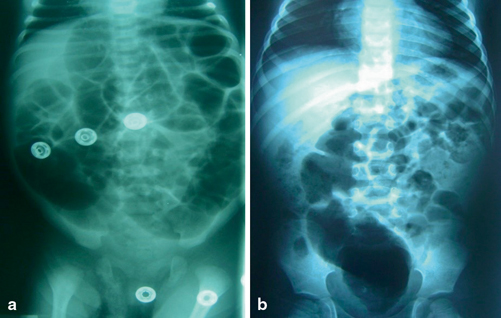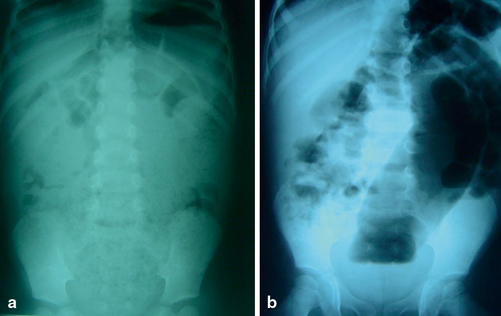Fig. 33.1
Barium enema showing congenital segmental dilatation of the rectosigmoid colon. Note the dilated segment and abrupt transition to a normal colon marked by the arrow
It is a very rare condition of unknown etiology and in all the neuronal enteric plexus is normal in the affected segment, proximally and distally.
Most cases are asymptomatic, discovered during exploration for other conditions namely:
Omphalocele .
Bowel atresia.
Anorectal malformations.
But there are reports of CSD causing intestinal obstruction, perforation, or bleeding (Fig. 33.2).

Fig. 33.2
Plain abdominal x-rays in two patients with congenital segmental dilatation of the rectosigmoid colon. The first one a showed features of neonatal intestinal obstruction while the other had constipation and abdominal distension. Note the air in the dilated segment of the rectosigmoid colon in the second film (b)
CSD can affect any part of the intestines from the duodenum to the rectum, with the ileum being the most commonly affected site.
Within the colon, the rectosigmoid region is the most affected site.
The presentation of CSD of the rectosigmoid colon is usually chronic constipation with abdominal distension and in the majority it is treated as functional constipation or the diagnosis is confused with Hirschsprung’s disease (Fig. 33.3).

Fig. 33.3
Plain abdominal x-rays of two patients with congenital segmental dilatation of the rectosigmoid colon showing chronic constipation in the first one (a) and an air‐fluid level in the second one (b). This is in the dilated segment of the rectosigmoid colon
Swenson and Rathauser were the first to describe CSD in 1959. They described three cases affecting the colon.
Etiology
The etiology of CSD is unknown and several theories have been proposed to explain its pathogenesis.
Irving and Lister proposed an extrinsic intrauterine intestinal compression such as an umbilical ring, vitelline vessels, or omphalomesenteric band.
This theory may explain the occurrence of CSD in association with omphalocele , but it does not however explain its occurrence in the other parts of intestines, especially the rectosigmoid colon.
Mathe et al. on the other hand proposed a primitive neuromuscular dysfunction of the bowel, but this does not explain the selective occurrence of segmental dilatation.
Stay updated, free articles. Join our Telegram channel

Full access? Get Clinical Tree


